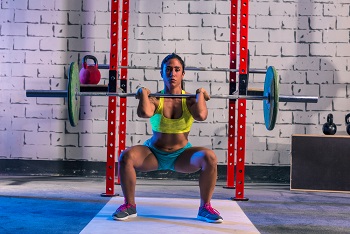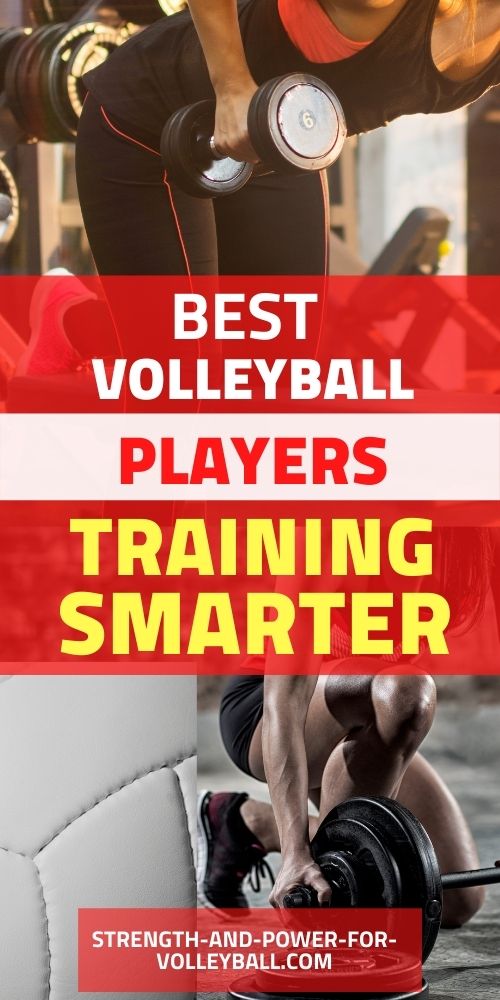Smarter Volleyball Training
Training to Maximize Your Potential
Volleyball training...you are what you train to be.
One of the goals of your
training for volleyball should be to create efficient movement. This
will allow you to conserve energy, play relaxed, and allow you to
practice and compete with less stress.
Being an efficient athlete. Being an efficient athlete means
performing your sport without wasted movement. By continuing to refine
your training, you will gain confidence and reduce any
anxiety about being prepared for competition.
By learning to train more efficiently, you will feel more athletic and volleyball skills will seem easier to master.
Bodybuilding vs Functional Training
A typical bodybuilding program is very different than
functional strength training. The goal of bodybuilding is about
improving muscle size and symmetry. Just because an athlete gets bigger
and stronger doesn't mean they are able to transfer that added muscle to
their sports performance.
It may be easier to design workouts
with exercises that isolate individual muscles, but by doing so makes it
difficult to get muscles to work together as an integrated system.
The
focus of functional training is on developing movement. The goal of
training is not to change how the body looks, but to improve how the
body moves.
Develop a Better Body
A great body is often a by-product of functional training. In fact, many personal trainers use the concepts of functional training in their programs when training their clients.
Training the kinetic chain. Rather than focusing on individual muscles, your volleyball training should involve moving multiple body parts.
Movement is complex, requiring the interaction of multiple muscle groups moving in all three planes of movement. Training should involve all the links in your body's kinetic chain working together to produce efficient movement.
If you enjoyed these tips and would like to keep it close to you at any time, just save this pin to your Pinterest Volleyball Training Board.
Correcting and Improving Movement Patterns
Poor biomechanics. Poor biomechanics refers to the
movement mistakes in which the body compensates and uses suboptimal
joint alignment, muscle coordination, and posture.
Because these
tiny errors in movement efficiency don't affect your sports
performance, you usually won't be aware of any problems. You may get
away with poor mechanics for awhile, but eventually these inefficiencies
will start causing problems.
Overtraining. Many people make the mistake of blaming microtraumas(small injuries) on overtraining. Overtraining is the result of doing too much of the right thing and not enough rest and recovery, but this is often not the cause of microtraumas. Microtraumas often occur because of a weak link in your body's chain of movement.
Conditioning vs. neuromuscular training. Weak links can be the
cause of many physical limitations such as poor movement patterns,
flawed coordination, incomplete sport skill, or lack of flexibility.
Before
starting a conditioning program, it may be best to identify a weak link
in your chain of movement. Once identified, focus on developing that
weakness at the beginning of your volleyball training cycle.
If
you don't correct weaknesses, you will continue to reinforce poor
technique and flawed neuromuscular compensation patterns. Being a
balanced athlete is key. Without balance you won't be efficient, and
then strength and power can't be maximized.
TRX Push Ups
Injury and Recovery
Soreness or pain? Soreness comes from hard work and training.
Pain indicates that there is a problem that needs to be fixed to prevent
further damage. Many athletes continuously push through the pain when
they train and compete.
Many athletes commonly use ice and
anti-inflammatory medications to the mask pain over a long time. Pain is
a warning that something is wrong. Pain should be seen as a signal that
something is not right.
Pain distorts proprioception. Listen to your body throughout your volleyball training phases. Each workout session can improve motor learning, coordination, and movement patterns. If pain distorts your body awareness, then chances are you will compensate and use unusual movements to avoid the pain.
Compensating movement patterns. Compensation is basically your
body looking for the best substitute available to perform a movement.
Compensation creates stress in other parts of the body as other areas
work harder to achieve the same level of performance.
New
problems arise when normal body parts must work in abnormal situations
or the athlete pushes into the pain, risking even greater injury with
more complications.
Testing Functional Movement
There are ways to test for
compensation patterns. Gray Cook has developed a movement screen for
testing both static and dynamic movements. These movement tests can be
used by just about anyone. For more information on Gray Cook's movement
screen, check out the FMS Website.
Many of these tests can be done by oneself and basically
involve analyzing an athletes mobility and stability by moving through
active ranges of motion and performing static postures.
Functional strength tests can also be done to identify a volleyball players strengths and weaknesses.
Determine the cause of pain. A better understanding of muscle function will allow your volleyball training to be more focused, logical, and exact.
An
understanding of the importance of training to be more functional
shifts the focus of "no pain, no gain" and "feel that burn" to feeling
the free flow and rhythm of efficient movement.
Muscular Imbalances
Pain could simply be caused by a muscle imbalance that has produced unnecessary stress in a joint or tendon. Covering up the symptom and pushing the joint further into activity can cause more damage.
Muscular imbalances at the shoulder joint are often caused by scapular muscle dysfunction which may lead to volleyball injuries at the rotator cuff. Your volleyball training should include shoulder stability exercises that target movement and stabilization of the scapulae.
By denying the pain you are ignoring one of the keys to refining your
volleyball training. It is important to get to the bottom of what causes
the pain.
If it is caused by a single injury, it is easy to
find the cause. If it has been developing over for a long period, find
out what caused it, where it came from, and what can be done to prevent
future problems.
Smarter Volleyball Training Related Pages
Stretching Before Practice
Volleyball stretches before practice gets your body ready for intense workouts. Not only does it help your muscles stay flexible and reduce injuries,
The Ultimate Volleyball Strength Program
...dominating your opponent with lightning fast speed, exceptional mobility and functional strength to make outstanding plays.
Learn to jump higher and hitting harder with an easy to learn workout requiring
little equipment...
Inner Core Training for Volleyball
You want a strong inner core because volleyball is a power endurance sport. A strong
diaphragm will help with quick explosive movements in volleyball. Easily have endurance for tournaments...
Volleyball Shoulder Injury Prevention Techniques
Volleyball shoulder injury prevention exercises. Your strength
training program should include exercises that help prevent shoulder
injuries. Most injuries are preventable. Use the following workout...
Volleyball Genetics and Strengthening Muscle for Volleyball
Volleyball genetics and what you can do to develop strength and
power for volleyball. Learn about muscle fiber types and what you need
to focus on to train for volleyball...
Training for Volleyball Joint by Joint
In the sports performance world, the phrase movements not muscles
has become common. The fact that many trainers are focused more on
movement is great progress. To take it a step further...
Ankle Mobility Strengthening Drills
Ankle mobility for volleyball. Six drills for strengthening the
ankles and improving mobility. Use the following techniques to
strengthen volleyball ankles, prevent injuries, pain, strains,
ACL tears...
Workout Recovery
Workout recovery is very important. How you spend your time away
from the weight room will determine the results you get from training.
Many factors including getting enough sleep, eating right, stretching...
Glute Training for Volleyball
Training your hips for volleyball is so important. Many times knee
and back injuries could have been prevented if the athlete were to have
proper functioning hips....
5 Tips for Increasing Volleyball Quickness
Volleyball quickness tips and keys to becoming a faster volleyball
player. Speed and agility drills likely aren't what you need to become
quicker. Activating the glutes and strengthening the psoas...
Building Absolute Strength and Speed
Absolute strength speed for volleyball. Strength is the foundation
for explosive power. In order to make explosive plays in volleyball...
Movement Skill Development and Coordination
Movement skill development for volleyball. The time between ages of 7
- 14 are important for developing coordination in young athletes.
Balance, rhythm, reaction...
Quick Volleyball
Quick volleyball players don't just train to get faster by doing
agility and speed workouts. The keys to improving quickness involve
increasing volleyball specific strength, stability, mobility...
Strength Training for Kids
Strength training for kids. Is it safe for young athletes to lift
weights? There are many concerns about stunting growth or becoming
injured from...
Volleyball Ankle Braces
Volleyball ankle braces have become a trend for volleyball players,
but are they safe? It makes sense that you need ankle support when
coming back from an injury, but...
Volleyball Ankle Supports
Volleyball ankle supports seem to be mainstream these days, but are
they necessary for all volleyball players at every level? Can ankle
braces make your ankles weaker?
Volleyball Strength Training Hamstrings
Exercises that involve training the hamstrings are commonly neglected when volleyball strength training.
Dead lift variations along with physioball leg curls...
Shoulder Drills for Volleyball Practice
Drills for volleyball practice should include shoulder warm up for
increasing shoulder mobility, flexibility, and stability. A good
shoulder warm up...
Functional Training for Volleyball
Volleyball training should include functional strength training to
prevent injuries and improve volleyball player performance. Volleyball
players...
Assessing Functional Strength for Volleyball
Developing functional strength is essential to being successful in
volleyball. Volleyball workouts should involve training strength...
Volleyball Weight Training for Increased Shoulder Stabilization
The shoulder is vulnerable to injuries mostly because of the strength
imbalances that surround it. Shoulder stabilization exercise...
Improving Movements
Movements in volleyball to learn to improve at getting in position faster to make outstanding plays. Learn the skills for movement and positioning.
Shoulder Exercises
Volleyball shoulder exercises Build strong healthy shoulders for spiking and serving.
Volleyball › Smarter Volleyball Training
- Home
- Smarter Training

